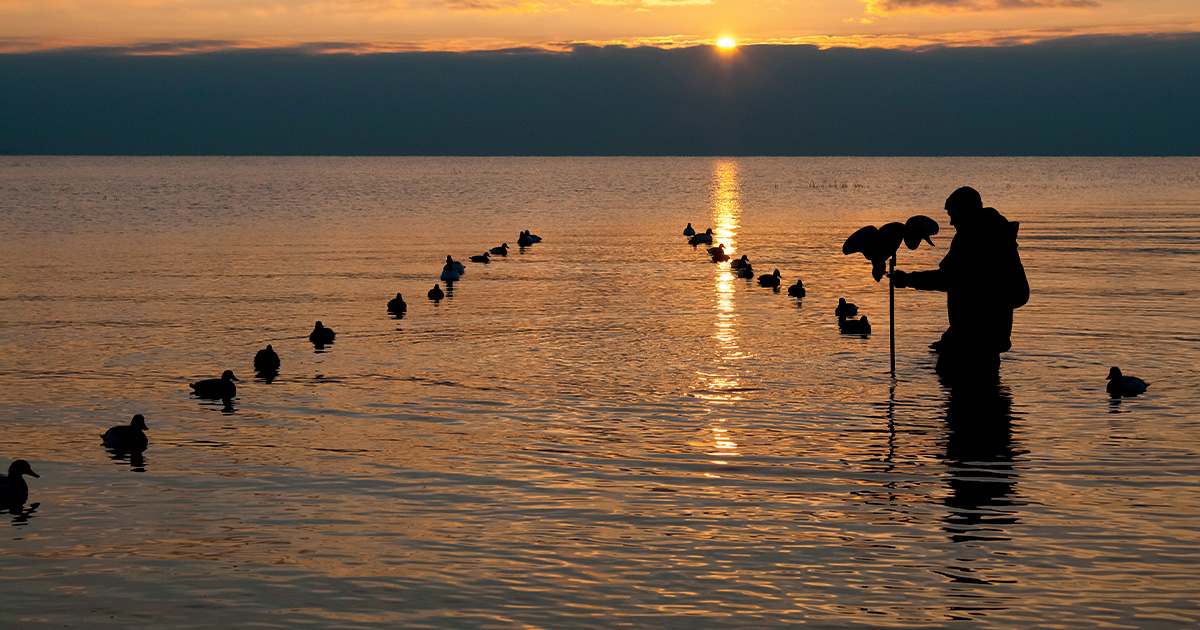Waterfowler's Journal: Diver-Hunting Basics
Here’s how to get started in this fast and furious sport
Here’s how to get started in this fast and furious sport


Hunting diving ducks on big water can offer action-packed wingshooting, but safety should always be top
of mind.
The diving duck species most commonly seen on inland waters include scaup, redheads, canvasbacks, ringnecks, buffleheads, and goldeneyes. Hunting these birds on open water is a very different experience than hunting mallards in flooded timber or pintails in rice fields. If you’ve always wanted to give diver hunting a try, check out the following tips.
Hunters who pursue puddle ducks in marshes and other small waters shoot plenty of incidental divers, but dedicated diving-duck hunting is mostly an open-water endeavor. Divers are hardy birds, and they’re content wherever they can find open water, security, and food.
With few exceptions, diver hunting requires a boat. Many big-water hunters use large, center-console fishing boats, but a 16- to 18-foot aluminum duck boat with a 25- to 60-horsepower outboard can suffice on smaller waters.
Water depth is important. A good rule of thumb is to set your decoys where the birds can’t see the bottom. For me, the ideal diver spot is a hard-bottom flat that’s 2 1/2 to 3 feet deep, which is enough for the ducks to dive, feed, and feel comfortable but also shallow enough to wade and set decoys. Deeper waters can be productive as well, but setting decoys and retrieving downed birds becomes more challenging.
Of course, with bigger water comes bigger risk. Before boating on open water in winter, be sure your engine is absolutely reliable, always wear a life jacket, and stock your boat with emergency supplies, including a change of clothes, fire starters, and multiple ways to contact help.
Diving ducks feed on mollusks, crustaceans, small fish, aquatic vegetation, and other submerged foods, so look for divers in areas with clean water and expansive shell beds, flats, and gravel bars. Pochard species such as bluebills, canvasbacks, and redheads frequently gather in huge rafts that are impossible to miss. Goldeneyes and buffleheads can seem antisocial by comparison, but even they will congregate by the dozens in a good area.
Noted Lake Erie diver hunter Greg Bires says that, in addition to looking for resting and feeding birds, it’s important to watch for preferred flight paths. Trading ducks will frequently follow contour edges between shallow areas and deep ones, similar to schooling fish. “On big water, the ducks have a lot of places to go,” he says. “But over time you can pay attention to the flight paths they use and the places they congregate, and you’ll see that they use the same waterways in the same places season after season.”
I love shooting from layout boats, but most days I hunt from shore, often on points, sandbars, and islands. A stiff breeze is crucial for diver hunting, and I have the best luck when the wind is at my back. Because divers are tough birds, your best odds for clean kills are when they decoy straight in.
Big spreads work on divers, but mobile hunters can be successful with as few as four to six dozen decoys. Bires runs three or four longlines with a couple dozen single decoys mixed in. My setup is similar. I usually have three longlines (mine are essentially catfish trotlines weighted on both ends and with decoys on the droppers instead of hooks), each with a dozen decoys. The lines fan out from my hide like turkey toes, with the closest decoys at 25 yards and the farthest at the edge of gun range.
At the head of the spread, 20 yards out, I fill in the spaces between the lines with two dozen individual decoys, along with a floating spinner or two. Bluebills and canvasbacks make up the bulk of my spread, but I also have a dozen goldeneye and bufflehead decoys off to the sides in their own groups. Those ducks usually decoy best to their own kind.
Divers aren’t particularly wary when working a spread. Sitting still next to a shoreline tree or on a rocky bank will usually suffice as a hide, though a good blind never hurts, because most puddle ducks will readily work a diver spread too. When the conditions are right with a good wind, divers will fly all day. Hunt accordingly and bring plenty of shells.
Ducks Unlimited uses cookies to enhance your browsing experience, optimize site functionality, analyze traffic, and deliver personalized advertising through third parties. By continuing to use this site, you agree to our use of cookies. View Privacy Policy